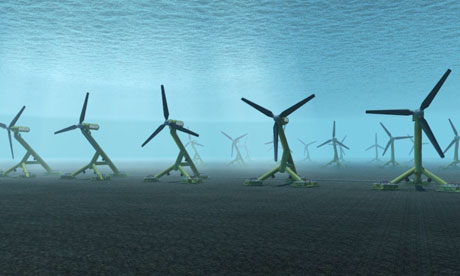Underwater power station to generate enough energy for 10,000 Hebridean homes, and some distilleries.
Severin Carrell Scotland correspondent

The world's first major tidal power station is to be installed in a deep, but sheltered, channel between two Scottish islands, providing electricity for up to 10,000 homes.
The array of 10 underwater turbines will be placed between the inner Hebridean islands of Islay and Jura, both well known for their malt whisky. They will generate about 10 megawatts (MW) of electricity, enough to power twice the number of homes on the islands, and to power the island's distilleries.
The devices, underwater versions of a wind turbine, will be placed on the ocean bed in the Sound of Islay, a kilometre-wide "canyon" with one of the strongest and most reliable tidal streams off the UK coast, flowing at almost 11 kilometres an hour (6.7mph).
"It's like a funnel," said a spokesman for ScottishPower Renewables, theenergy company behind the £40m project. "It's a very strong tidal stream, and it's very predictable. It's one of the best we could have in Scotland."
The project has been authorised by John Swinney, the Scottish finance secretary, because the scheme is sited within the Holyrood constituency of the energy minister Jim Mather. Swinney said it was the largest scheme of its kind in the world.
"With around a quarter of Europe's potential tidal energy resource and a tenth of the wave capacity, Scotland's seas have unrivalled potential to generate green energy, create new, low carbon jobs, and bring billions of pounds of investment to Scotland," Swinney said. "This development – the largest tidal array in the world – does just that and will be a milestone in the global development of tidal energy."
The Islay scheme will use a turbine developed by Hammerfest Strøm AS, a Norwegian company part-owned by ScottishPower Renewables' parent company, the Spanish energy giant Iberdrola. A scaled-down, 300kw, prototype has already been tested off Norway and the same 1MW model is now being tested in the Pentland Firth off north Scotland.
Philip Maxwell, chairman of the community-owned Islay Energy Trust, said the islanders were "delighted" by the project. "It's great, and there's a feeling on the island that the people own the project," he said.
Similar to onshore windfarm projects paying rent to local communities, the trust will receive a cut of the profits from the tidal scheme and has already had other funding from ScottishPower Renewables. It has also promised to use local contractors. The first turbines could be in place from 2013, with the full project running by 2015.
The trust's share will be reinvested in green energy projects on Islay, including subsidised solar photovoltaic panels and wind turbines, and may be used to fund offshore wind and marine power projects in the future. It may also experiment with electric cars.
ScottishPower Renewables has also signed a deal with the drinks giant Diageo to provide it with all the electricity needed for eight of its whisky distilleries and maltings on Islay from the tidal array.
Alex Salmond, Scotland's first minister, has claimed that this marine energy source could help the country to become the "Saudi Arabia of offshore renewables".
While environmentalists are very enthusiastic about the potential for marine power, many believe Salmond is heavily promoting offshore energy to avoid taking far more politically challenging steps to tackle emissions from transport, industry and homes.
Successive Scottish governments have been reluctant to take measures to curb rising car use, cut road building programmes or to push for new, greener forms of transport such as low-carbon vehicles. One of the Scottish National party's core areas of support is the North Sea oil industry-dominated region around Aberdeen.
Nenhum comentário:
Postar um comentário